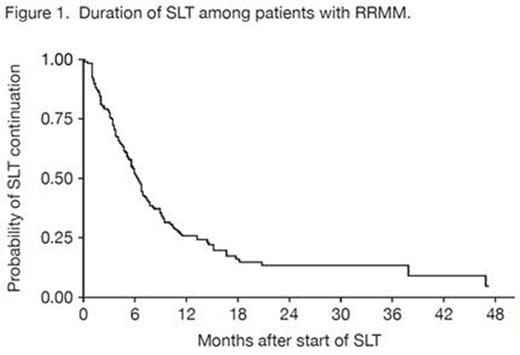Abstract
Background
Multiple myeloma (MM) is the second most common hematologic cancer in adults. Novel agents, including thalidomide, bortezomib, and lenalidomide, have led to improved overall survival (OS) in MM, but the disease remains generally incurable with the majority of patients inevitably relapsing after front-line therapy (FLT). In a multi-center observational analysis of 383 MM patients (treated between 2007 and 2010), median progression-free survival (PFS) and OS from treatment after first relapse were 13 and 35 mos (Durie ASCO 2012; abs 8095). According to NCCN guidelines, retreatment with primary therapy may be considered if relapse occurs more than 6 mos after discontinuation of primary therapy, otherwise a switch in regimen is recommended (NCCN MM Guidelines v.4 2015). Treatment patterns and outcomes in RRMM remain to be elucidated. We examined treatment use, retreatment and therapy switch patterns, and outcomes among patients with RRMM initiating second-line therapy (SLT).
Methods
We conducted a retrospective cohort study using a large, national, US claims database. Adult patients with MM who initiated cancer-specific systemic therapy between Jan 2008 and Feb 2014, without evidence of transplantation, were identified. Newly diagnosed MM patients were followed from the first claim for MM. Continuous enrollment in the health plan for 12 mos pre-diagnosis (with no claim for MM) through at least the start of SLT was required. FLT began with the first claim for MM-directed systemic cancer therapy. Unique agents administered within 90 days of FLT initiation constituted a regimen. Continuation of FLT regimen (or part thereof) or monotherapy within 3 mos of the end of the initial regimen was considered part of FLT. SLT after first relapse for RRMM was identified accordingly: 1) a treatment gap >6 mos between end of FLT and start of a second regimen (retreatment or switch), 2) start of a follow up regimen (retreatment) with a treatment gap of >3 and up to 6 mos after end of FLT, or 3) a switch to another drug combination after FLT regimen. Analyses were conducted from the first claim for SLT. SLT ended at the earliest of start of a new drug, death, or end of study period (Feb 2014). MM drug combinations were based on all unique MM systemic therapy agents received within start and end date for SLT. Vital status information was ascertained from the Social Security Death Index.
Results
We identified 249 patients with RRMM receiving SLT. Approximately half (49%) were male; 29% and 43% were aged 65-74 and 75 years or older, respectively. SLT regimens were: lenalidomide±dexamethasone (R±d, n=70 [28%]), bortezomib±d (V±d 61 [25%]), other (58 [23%], see Table 1), V+other (25 [10%]), R+other (14 [6%]), V-cyclophosphamide±d (VC±d, 13 [5%]), and VR±d (8 [3%]). The switch and retreatment patterns from FLT to SLT are depicted in Table 1. Among patients with treatment-free interval (TFI, time from end of FLT to start of SLT) >6 mos (n=64) vs ≤6 mos (n=185), 18 (28%) vs 17 (9%) were retreated with the same primary regimen in SLT, respectively. Median duration of SLT was 6.3 (95% CI: 5.6, 6.9) mos (Fig. 1) and of FLT was 6.8 (95% CI: 6.0, 7.8) mos. The 1-year OS probability from initiation of SLT for RRMM was 82% (95% CI: 76%, 86%).
Conclusions
Among patients with RRMM treated in the USA, V- and R-based regimens were the most common at first relapse. The vast majority of patients (91%) with TFI ≤6 mos switched therapy at time of relapse in concordance with NCCN guidelines. The relatively short duration of SLT (median 6.3 mos) in this study compared with PFS from treatment after first relapse (median 13 mos, Durie ASCO 2012; abs 8095) in a cohort of patients with RRMM, suggests that the majority of patients discontinue SLT prior to disease progression. These findings highlight the need for newer SLT regimens that are effective and more sustainable compared with current treatment choices.
Switch and Retreatment Patterns from FLT to SLT among Patients with RRMM. SLT
| . | . | V-based . | R-based . | VR-based . | Other . |
|---|---|---|---|---|---|
| FLT | V-based | 41 (41%) | 49 (58%) | 4 (50%) | 15 (26%) |
| R-based | 33 (33%) | 13 (15%) | 2 (25%) | 12 (21%) | |
| VR-based | 9 (9%) | 6 (7%) | 2 (25%) | 19 (33%) | |
| Other* | 16 (16%) | 16 (19%) | 0 (0%) | 12 (21%) | |
| Total | 99 (100%) | 84 (100%) | 8 (100%) | 58 (100%) |
| . | . | V-based . | R-based . | VR-based . | Other . |
|---|---|---|---|---|---|
| FLT | V-based | 41 (41%) | 49 (58%) | 4 (50%) | 15 (26%) |
| R-based | 33 (33%) | 13 (15%) | 2 (25%) | 12 (21%) | |
| VR-based | 9 (9%) | 6 (7%) | 2 (25%) | 19 (33%) | |
| Other* | 16 (16%) | 16 (19%) | 0 (0%) | 12 (21%) | |
| Total | 99 (100%) | 84 (100%) | 8 (100%) | 58 (100%) |
*Other combinations consisted of a subset of the following agents: cyclophosphamide, melphalan, vincristine, doxorubicin, interferon-alpha, pomalidomide, thalidomide, carfilzomib, dexamethasone, prednisone
Romanus:Millennium Pharmaceuticals Inc., a wholly owned subsidiary of Takeda Pharmaceutical Company Limited: Employment. Jhaveri:Sanofi: Equity Ownership; Takeda Pharmaceutical Company Limited: Equity Ownership; Millennium Pharmaceuticals Inc., a wholly owned subsidiary of Takeda Pharmaceutical Company Limited: Employment. Labotka:Millennium Pharmaceuticals, Inc., Cambridge, MA, USA, a wholly owned subsidiary of Takeda Pharmaceutical Company Limited: Employment. Henk:Optum (a consulting firm retained by Takeda to conduct the reasearch pertaining to this abstract): Employment. Seal:Millennium Pharmaceuticals Inc., a wholly owned subsidiary of Takeda Pharmaceutical Company Limited: Employment.
Author notes
Asterisk with author names denotes non-ASH members.


